If you want to make your network run faster, buy good fiber switches. Fiber switches are key parts of any business or home internet setup. They are faster than copper-wire switches and cut down on lag time, too. What’s more? This system is also more reliable than the traditional options since it reduces failure rates by improving connections between computers and other devices in a network. This technology also allows for quicker data transfers, which can handle large amounts of bandwidth, so heavy traffic won’t be an issue anymore.
In this post, we’re reviewing some of the best fiber switch choices right now! We’ll take a look at what they have going on specification-wise and how well these things perform overall. That way, when it comes time to decide which one suits your needs best, there will be no shortage of information available! So whether upgrading current infrastructure or planning new installations, understanding the advantages plus technicalities behind such devices becomes important in selecting the most appropriate answers based on individual requirements. Ensure not to miss anything because after that, deep reviews where different models are compared against each other, hoping to provide top suggestions for upgrading networks.
Why Choose a Fiber Optic Switch for Your Network?

Comparing Fiber to Copper: The Benefits for Your Network
The first difference is through transmission speed. Copper cables have limited bandwidth capacity as compared to fiber optic cables which can support faster data transfer rates necessary for high-demand applications. Secondly, latency is much lower when using fiber optics. Data travels at close to light speed along these cables therefore taking very little time.
Another significant benefit is signal integrity. Electromagnetic interference does not affect signals carried by fiber-optic cables, hence ensuring that information remains intact over long distances. They are suitable for areas with electronic interferences, too. Moreover, fiber optics last longer and need less maintenance than copper wires corrode easily due to physical tear and wear.
Understanding Fiber Switch Transmission Speeds and Protocols
When it comes to transmission speeds, fiber switches can operate at different standardized speeds. Examples of these are 1 Gbps (Gigabit Ethernet), 10 Gbps (10 Gigabit Ethernet), 40 Gbps and even 100 Gbps. The choice of speed depends on the needs of your particular network and its future scalability.
Protocols are also important considerations. Below are some commonly used protocols with fiber switches:
- Ethernet (1 Gbps, 10 Gbps, 40 Gbps, 100 Gbps) – This is the main protocol for most data networks.
- Fiber Channel (16 Gbps, 32 Gbps) – Often used in Storage Area Networks (SANs) for fast data transfer between storage devices.
- InfiniBand – This is known for having very low latency and is used in high-performance computing environments.
The Role of SFP Ports in Enhancing Network Flexibility
The flexibility and scalability of a network are greatly improved by SFP (Small Form-factor Pluggable) ports. These are plug-in modular ports that allow for transceivers to be changed without powering down the whole system. Below are a few advantages of this:
- Adaptability: SFP ports can work with different speeds and distances within a network due to their support for various types of transceivers such as SFP (1 Gbps), SFP+ (10 Gbps) or QSFP+ (40 Gbps).
- Hot-swappable: This feature enables modules to be replaced or upgraded while the network is still running, thus reducing downtime.
- Compatibility: Single mode fiber optic cables as well as multimode fibers among other types can all be used with SFPs hence extending their reach and versatility.
In summary, when it comes to speed, reliability and flexibility fiber optics switches outperform copper-based switches by far. You can therefore optimize your network so that it meets specific requirements more effectively once you understand how transmission speeds vary with different devices like those having an SFP port installed.
How to Select the Right Port Configuration

Determining the Right Number of Ports for Your Needs
Determining the best number of ports for your network setup can be summarized in a few points:
- Current Network Size: Count the total number of devices that you currently have to connect. This involves computers, servers, printers, and other peripherals.
- Growth Plans: Forecast needs for next 2-3 years atleast. This includes new devices, increased user demand and potential network expansion.
- Redundancy: Consider additional outlets in case hardware fails or unanticipated connections are made.
- Network Traffic: Analyze demands on traffic within the network. In high-traffic areas, it may be necessary to add more switch ports so as not to cause performance degradation through congestion points.
- Budget Constraint: Cost should always be weighed against value received; higher priced switches having more ports than cheaper ones should only purchased if they’re needed.
The Difference Between Managed, Unmanaged, and Smart Fiber Switches
To pick the right type of fiber switch, you need to know the difference between managed, unmanaged, and smart switches.
Managed Switches:
Pros:
- Complete authority over network traffic
- Extra features such as VLANs, Quality of Service (QoS), and network monitoring tools
- Enhanced security capabilities
Cons:
- Higher price
- Requires technical knowledge to set up and operate
Unmanaged Switches:
Pros:
- Plug-and-play simplicity
- Lower cost
Cons:
- Lack of additional functions
- No command on network traffic
Smart Switches:
Pros:
- Combine easy usage with some management features.
- More affordable than fully managed switches.
Cons:
- Functionally limited compared to fully managed switches.
16 Port Gigabit vs. 8 Port Gigabit: What’s Best for Your Setup?
Choosing between a 16-port and an 8-port switch depends on what you need:
A number of Current and Future Devices:
- 16 Port: If you have or are expecting more than eight devices, this allows for growth.
- 8 Port: Works well in small networks with fewer devices or when budget is a limiting factor.
Network Performance:
- 16 Port: Can eliminate bottlenecks in larger networks by enabling more direct connections, thus potentially improving overall efficiency.
- 8 Port: Fine for smaller networks with light-to-moderate traffic loads.
Space and Installation:
- 16 Port: This takes up more room physically and may involve a more involved installation process.
- 8 Port: Smaller and easier to install in tight spaces.
Budget:
- 16 Port: Generally pricier due to the increased number of ports and possibly enhanced functionalities.
- 8 Port: More cost-efficient for SMBs (small-to-medium-sized businesses) or home use
Assessing these criteria should enable you to choose wisely vis-a-vis your network needs and operational aims.
Fiber Switches and Ethernet Compatibility
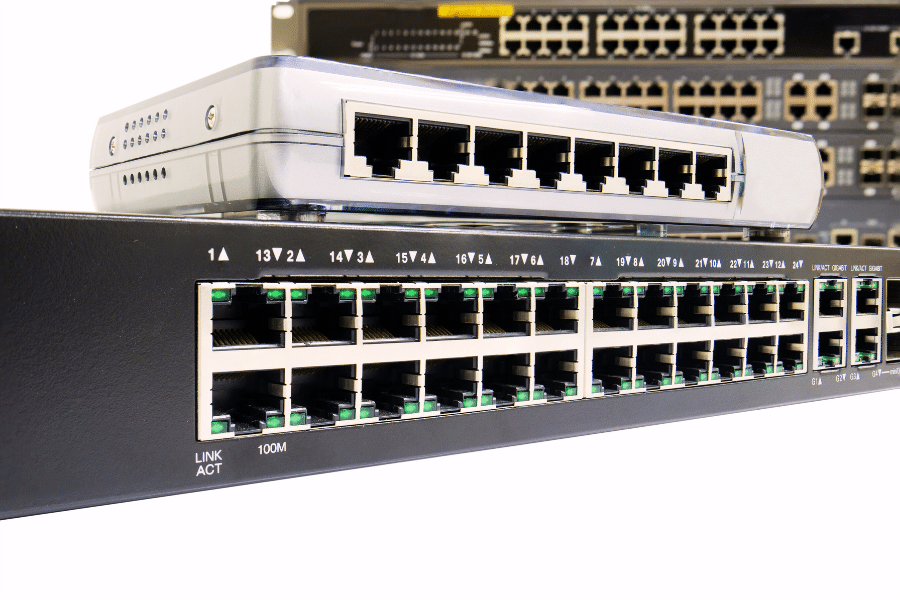
Integrating Fiber Switches with Existing Ethernet Networks
The benefits of integrating fiber switches into an established Ethernet network are tremendous in terms of speed, reliability, and distance. However, it is important to bear some factors in mind to ensure a smooth integration. Here are the considerations;
Support of Gigabit Ethernet:
To sustain high-speed connectivity, a fiber switch should have the capability for Gigabit Ethernet support. This will keep the data transfer rates efficient and uniform across the network.
Port Compatibility:
- RJ45 Ports: These are standard Ethernet ports where network cables plug into devices. Ensure that the fiber switch has RJ45 ports so as to accommodate those devices that do not have fiber capabilities.
- SFP Ports: SFP (Small Form-Factor Pluggable) ports provide flexibility in terms of network interfaces. SFP modules can be changed out for different types of fiber connections thus making them compatible with various devices as well as future-proofing the network.
Seamless Connectivity:
- Having both RJ45 and SFP ports on the fiber switch makes it easy to integrate since there isn’t much need for additional adapters or converters. This configuration allows copper Ethernet and fiber connections to work together.
Cabling Infrastructure:
- Assessing the existing cabling infrastructure will help determine whether new fiber optic cables will be needed or if current ones can support integration. This evaluation is important as it ensures best performance while minimizing possible disruptions during implementation.
If you address these parameters in a methodical way, you will be able to integrate Fiber Switches into your Ethernet Network effectively thereby creating a strong environment that supports high-performance networks using both technologies.
Exploring the Best Brands and Product Features

What to Look for in Fiber Switch Product Descriptions
To be able to choose the best switch for your networking needs from the descriptions of fiber switch products, it is important that you bear in mind a few considerations. Here are the main parameters:
Port Density and Type:
Look for a combination of RJ45 ports that cater to copper Ethernet cables and SFP ports designed specifically for fiber optic links.
Port density should be high enough to allow connection of multiple devices as this is essential when scaling networks.
Speed and Bandwidth:
Check whether or not the switch supports Gigabit Ethernet at least; otherwise, 10 Gigabit per second should be supported, too, for faster data transfer rates.
Quality of Service (QoS):
With QoS capabilities installed on switches we can prioritize packets based on their specific requirements, which helps improve performance where delay times are critical such as voice over IP telephony (VoIP) systems or video conferencing applications etc.
Management Capabilities:
Managed switches come with advanced features like support for virtual local area networks (VLANs), network monitoring tools plus remote configuration options among others.
Reliability and Redundancy:
Power supplies need to be redundant so that if one fails, another can take over automatically without causing any interruption; hence, this ensures uninterrupted operation even during power failures. Also, protocols may have been put in place for example, Rapid Spanning Tree Protocol (RSTP), that will ensure switching between backup links happens quickly enough before users notice anything wrong has happened, etc
Security Features:
Some security measures could include port security, 802.1X authentication while Access Control Lists (ACLs) help in restricting traffic flow through specific ports thus preventing unauthorized access to certain parts of the network.
Energy Efficiency:
IEEE 802.3az compliant devices consume less power, hence saving energy, therefore making these types environmentally friendly too.
Top Brands Offering High-Speed and Reliable Fiber Optic Switches
A number of well-known companies are famous for their fiber optic switches, which are both fast and dependable. Some leaders in the field include:
Cisco:
These switches are tough and equipped with many features. Cisco offers models with advanced management options, extensive security measures, and high reliability.
Juniper Networks:
Scalability is the hallmark of Juniper’s high-performance switches, which work best in large enterprise networks.
Arista Networks:
Designed for data centers, these switches support high-speed data transfer and low latency.
Netgear:
This brand offers a variety of affordable fiber switches suitable for small—to medium-sized businesses. They also have user-friendly management interfaces.
HPE (Hewlett Packard Enterprise):
Switches by HPE are known for being durable and reliable. They also offer excellent scalability and robust performance features.
Special Features to Enhance Network Performance and Security
Certain features can make your network more powerful and secure. Here are a few considerations:
Level 3 Routing:
This allows a switch to perform routing functions, increasing network efficiency and reducing the load on dedicated routers.
Double Power Supplies:
This provides redundancy so that the switch will still work even if one power supply fails.
Advanced Threat Protection:
Additional security is provided by firewall integration as well as intrusion detection/prevention systems.
Monitoring and Analytics for Networks:
Real-time monitoring tools with detailed analytics enable proactive network management and fast troubleshooting.
Considering these criteria and capabilities, you can choose a fiber switch that boosts performance, reliability, and security across your network.
Fiber Switch Shopping: What to Consider

Shop Smart: Feature Checklists and Must-Have Qualities
When buying a fiber switch, it is important to evaluate different features and must-have qualities in order to ensure that you’re getting the most bang for your buck. Below is an inclusive checklist to help you out:
Port Density:
Identify how many ports you require. Having a higher port density can support additional devices and future-proof your network.
Speed and Performance:
Check the switch’s speed capabilities (e.g., 1Gbps, 10Gbps) vis-à-vis your data transfer needs.
Management Features:
Look for easy-to-use management interfaces like web-based GUIs or CLI options for simple configuration and monitoring.
Reliability and Redundancy:
Dual power supplies and hot-swappable components, among other things, increase reliability while minimizing downtime.
Security Protocols:
Ensure there are advanced security features such as Access Control Lists (ACLs), VLANs, integrated threat protection, etc.
Scalability:
Choose switches that have stacking capabilities or those with modular designs that allow room for growth later on.
Warranty and Support:
Comprehensive warranty terms plus round-the-clock customer support can give you peace of mind, knowing that there will always be someone available to offer technical assistance when required.
Reading Reviews and Specifications: Key to Finding the Perfect Switch
Finding the best switch for your fiber optic network can be a daunting task. However, with reviews and technical specifications, you can easily find what you are looking for. Here’s how to do it:
Customer Reviews
Check out customer feedback on e-commerce platforms or tech forums. What aspects are they commending or complaining about about reliability, performance or ease of use?
Technical Specifications
Go through the detailed specifications from manufacturers against your checklist to ensure all the essential features are included.
Expert Reviews
Refer to expert reviews which usually test different scenarios of use and also make benchmark comparisons.
Price Comparison
Use price comparison tools to find out where the fiber switches are sold cheaply by different dealers; remember that shipping costs, taxes and any other levies should also be considered .
Manufacturer Reputation
Consider a brand’s reputation for quality service delivery after purchase, especially if it has been around for some time, because this could save you from troubles later on when things go wrong with your device.
Certification And Compliance
Ensure that the switch meets industry standards such as IEEE compliance which guarantees certain levels of quality as well as interoperability among various devices used within an organization’s network infrastructure setup.
The above parameters should help you decide which fiber switch is right for you. However, do not forget that reading user reviews and expert opinions will always give better insights into what might work best in different environments, as well as help you save money through deals.
Setting Up Your New Fiber Switch: Tips and Tricks

Quick Setup Guide for Your New Fiber Optic Switch
Unpacking and checking:
Take out your new fibre optic switch from its packaging and look for any signs of damage. Confirm that all peripherals like power cords, mounting brackets, and user guides are present.
Physical setting up:
Choose a suitable location for the switch, preferably somewhere cool with good ventilation so it does not overheat. Fix it in place by using the provided brackets if designed for rack installation.
Power connection:
Plug one end of the power cable into the switch, and then connect the other end to an electrical outlet that supplies stable power. Switch it on and check whether the power indicator LED lights up.
Cable Connections for Networking:
Insert your fiber optic cables into the appropriate SFP ports. Observe color coding and port labeling to prevent mismatching. Ensure the tightness of the connections made.
Initial setup:
Using a console cable, link your computer’s console port to that of a switch. Launch the terminal application and follow the first-time settings outlined in the user manual, such as assigning the IP address, subnet mask, and default gateway, among other basic configurations.
Management Interface Access:
To do more configurations, access the web-based management interface for this particular type of switch through any web browser. You may have Login using default credentials provided in the manual when necessary.
Maximizing Performance: Configuration Tips for Advanced Users
VLAN Configuration:
Create virtual LANs (VLANs) to divide your network into segments and thus increase security while reducing broadcast traffic. This can be done in the VLAN management part of the web interface.
Quality of Service (QoS):
Implementing quality of service (QoS) prioritizes critical traffic like voice over IP (VoIP) and streaming services. This guarantees that enough bandwidth is available for high-priority applications.
Link Aggregation:
To increase bandwidth and provide redundancy, you can use the Link Aggregation Control Protocol (LACP) to bundle several physical links into one logical link.
Spanning Tree Protocol (STP):
STP must always be enabled to prevent network loops and ensure a loop-free topology, which is so important in maintaining network performance and stability.
Firmware Updates:
It is necessary to frequently visit manufacturer’s website for firmware updates which should then be installed promptly. These usually come with patches against security risks besides enhancing performance.
Troubleshooting Common Installation Issues
Power Issues:
Make sure that the power supply is stable and that you have correctly plugged in the power cable. Look for any tripped circuit breakers or faulty power strips.
No Link Light:
If the link light fails to come on, confirm that the optical fiber cables are properly fixed. Examine the connectors for dust or damage and clean them if necessary.
Console Access Problems:
Ensure correct connection of console cable and terminal settings matching switch default configuration (baud rate, data bits, parity, stop bits).
Network Performance Issues:
Ensure no high CPU or memory usage on a switch; it may indicate either too much network traffic or misconfiguration. Monitor traffic and adjust configurations accordingly.
Configuration Errors:
Carefully go through the steps of configuration, then check the user manual for recommended settings. In case necessary, factory reset the switch and then restart the configuration process.
Reference sources
- TechRadar – “The Best Network Switches of 2024”
URL: TechRadar
Summary:This 2024 TechRadar article compares the best network switches and fiber switches. The switches are ranked by their speed, number of ports, ease of use, and extra features. If you want to upgrade your network with high-speed fibers, this article will help you because it provides detailed specs along with user reviews. - FS Community – “How to Select the Best Gigabit Switch for Home Network”
URL: FS Community
Summary:The FS Community guide helps you choose the best gigabit switch for your home network. It includes a section on fiber switches. The guide highlights speed, scalability, and port requirements, as well as gives practical tips and technical information, making it useful for beginners through advanced people who are looking at upgrading their fiber switches. - Tom’s Hardware – “Best Network Switches: Add Ports, Speed to Your Network”
URL: Tom’s Hardware
Summary: Tom’s Hardware presents an in-depth analysis of different network switches that support fiber connections. It also shows why you should upgrade to a fiber switch, like faster speed and better reliability. They have provided performance tests as well as some buying advice while remaining unbiased and credible within the tech community.
Frequently Asked Questions (FAQs)

Q: What should I consider when choosing a fiber switch for my network?
A: While picking a fiber switch for your network, think about the number of ports; whether you need an ethernet switch with Power over Ethernet (PoE) ports for devices such as VoIP phones or wireless access points; and the data speed provided by the switch. Moreover, in UK commercial or residential use, what type of switch – layer 2/ intelligent layer 3 – you choose may be crucial depending on how complex your networks are to manage.
Q: How does an ethernet switch in the fiber network enhance my internet speed?
A: An ethernet switch can dramatically increase internet speeds within networks through efficient management of data traffic and reduction in congestion. When designed for fiber optic networks, high-speed ethernet switches ensure that bandwidth is available for simultaneous communication between multiple devices without any hitches related to it running out. This is especially useful in business settings where there needs to be fast and dependable connectivity every day.
Q: Can I also use a fiber switch at home, or is it overkill?
A: Yes! You can definitely use fiber switches at home, especially if many devices are connected simultaneously or when gaming, streaming videos, or working from the home office, among other activities that require high-speed internet connection. A desktop PoE Ethernet Switch might also catch your eye since not only does it provide high-speed connections but also powers devices such as VoIP phones and surveillance cameras, making it a very versatile addition to any home network setup.
Q: What are some benefits of having PoE ports on a fiber network switch?
A: The inclusion of PoE ports on a fiber network switch makes it possible to power devices directly via ethernet cables thus eliminating separate power supplies which can be quite cumbersome. This is more so advantageous for IP cameras, wireless access points (WAPs) or VoIP phones among others where using these types of switches simplifies their installation as well as management making them intelligent choice even for residential setups.
Q: How can I tell if I need a commercial grade fiber Ethernet switch for my business in UK?
A: If you are managing large amounts of data within UK-based operations, require support for multiple simultaneous high-speed internet connections, or require advanced network management and security features, then commercial-grade fibre optic Ethernet switches would suit you best. They offer the performance reliability needed to handle commercial networks’ demands efficiently.
Q: For enhanced network performance through fiber switches, which aspects should I focus on?
A: To achieve top-notch network results, consider fast data transfer rates, multiple support of fiber connections, quality of service settings to prioritize certain traffic, or PoE ports that can power devices directly. Besides, an intelligent or managed switch rather than a basic hub can greatly affect the speed at which your network operates.
Q: How do I ensure that the fiber switch I choose complements my existing network?
A: To guarantee compatibility, make sure that the standards and protocols supported by the switch match those used in your current setup. It should also have enough ports of the right type for both present and future needs and be able to handle speeds similar to those of other equipment in use. Additionally, select a device that will not require many changes during integration into your existing network architecture.
Q: Are layer 2 switches different from layer 3 switches when working with fiber networks?
A: Yes, they are. Layer two works within the data link by switching ethernet frames among devices on one particular local area network, while level three carries out this function but operates at the network level too, enabling packet routing between different networks and offering more advanced IP routing capabilities. So, if you have complex setups that require interconnecting various subnets, then go for layer three instead.
Related Products:
-
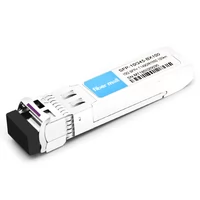 SFP-10G45-BX100 10G BX SFP+ BIDI TX1490nm/RX1550nm 100km LC SMF DDM Transceiver Module
$700.00
SFP-10G45-BX100 10G BX SFP+ BIDI TX1490nm/RX1550nm 100km LC SMF DDM Transceiver Module
$700.00
-
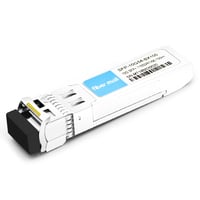 SFP-10G54-BX100 10G BX SFP+ BIDI TX1550nm/RX1490nm 100km LC SMF DDM Transceiver Module
$700.00
SFP-10G54-BX100 10G BX SFP+ BIDI TX1550nm/RX1490nm 100km LC SMF DDM Transceiver Module
$700.00
-
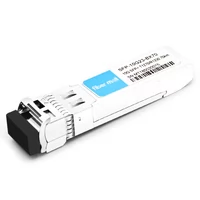 SFP-10G23-BX70 10G BX SFP+ BIDI TX1270nm/RX1330nm 70km LC SMF DDM Transceiver Module
$100.00
SFP-10G23-BX70 10G BX SFP+ BIDI TX1270nm/RX1330nm 70km LC SMF DDM Transceiver Module
$100.00
-
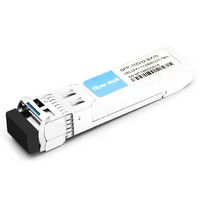 SFP-10G32-BX70 10G BX SFP+ BIDI TX1330nm/RX1270nm 70km LC SMF DDM Transceiver Module
$100.00
SFP-10G32-BX70 10G BX SFP+ BIDI TX1330nm/RX1270nm 70km LC SMF DDM Transceiver Module
$100.00
-
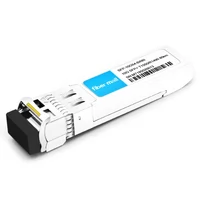 SFP-10G54-BX80 10G BX SFP+ BIDI TX1550nm/RX1490nm 80km LC SMF DDM Transceiver Module
$400.00
SFP-10G54-BX80 10G BX SFP+ BIDI TX1550nm/RX1490nm 80km LC SMF DDM Transceiver Module
$400.00
-
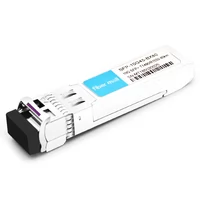 SFP-10G45-BX80 10G BX SFP+ BIDI TX1490nm/RX1550nm 80km LC SMF DDM Transceiver Module
$400.00
SFP-10G45-BX80 10G BX SFP+ BIDI TX1490nm/RX1550nm 80km LC SMF DDM Transceiver Module
$400.00
-
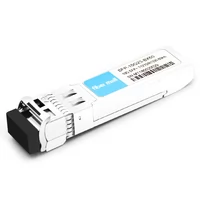 SFP-10G23-BX60 10G BX SFP+ BIDI TX1270nm/RX1330nm 60km LC SMF DDM Transceiver Module
$75.00
SFP-10G23-BX60 10G BX SFP+ BIDI TX1270nm/RX1330nm 60km LC SMF DDM Transceiver Module
$75.00
-
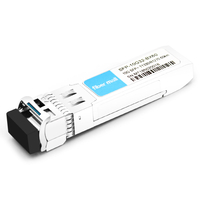 SFP-10G32-BX60 10G BX SFP+ BIDI TX1330nm/RX1270nm 60km LC SMF DDM Transceiver Module
$75.00
SFP-10G32-BX60 10G BX SFP+ BIDI TX1330nm/RX1270nm 60km LC SMF DDM Transceiver Module
$75.00
-
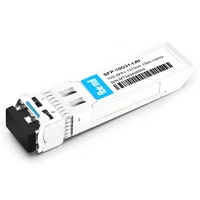 SFP-10G31-LRI 10G SFP+ LR 1310nm 10km LC SMF DDM Industrial High Temperature Transceiver Module
$22.00
SFP-10G31-LRI 10G SFP+ LR 1310nm 10km LC SMF DDM Industrial High Temperature Transceiver Module
$22.00
-
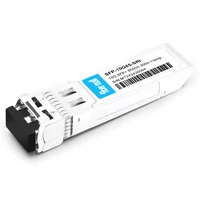 SFP-10G85-SRI 10G SFP+ SR 850nm 300m LC MMF DDM Industrial High Temperature Transceiver Module
$15.00
SFP-10G85-SRI 10G SFP+ SR 850nm 300m LC MMF DDM Industrial High Temperature Transceiver Module
$15.00
-
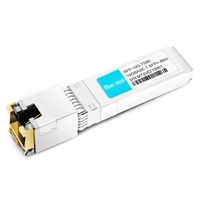 SFP-10G-TS80 10GBase-T Copper SFP+ to RJ45 80m Transceiver Module
$55.00
SFP-10G-TS80 10GBase-T Copper SFP+ to RJ45 80m Transceiver Module
$55.00
-
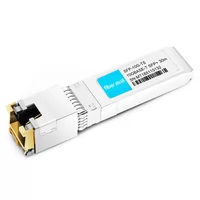 SFP-10G-TS 10G Copper SFP+ 30m RJ45 Transceiver Module
$45.00
SFP-10G-TS 10G Copper SFP+ 30m RJ45 Transceiver Module
$45.00
-
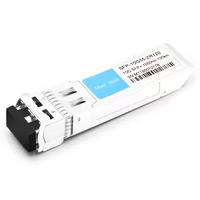 SFP-10G55-ZR120 10G SFP+ ZR 1550nm 120km LC SMF DDM Transceiver Module
$550.00
SFP-10G55-ZR120 10G SFP+ ZR 1550nm 120km LC SMF DDM Transceiver Module
$550.00
-
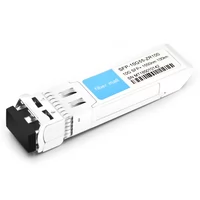 SFP-10G55-ZR100 10G SFP+ ZR 1550nm 100km LC SMF DDM Transceiver Module
$300.00
SFP-10G55-ZR100 10G SFP+ ZR 1550nm 100km LC SMF DDM Transceiver Module
$300.00
-
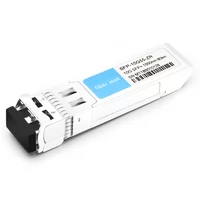 SFP-10G55-ZR 10G SFP+ ZR 1550nm 80km LC SMF DDM Transceiver Module
$150.00
SFP-10G55-ZR 10G SFP+ ZR 1550nm 80km LC SMF DDM Transceiver Module
$150.00
-
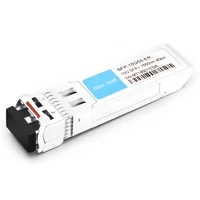 SFP-10G55-ER 10G SFP+ ER 1550nm 40km LC SMF DDM Transceiver Module
$80.00
SFP-10G55-ER 10G SFP+ ER 1550nm 40km LC SMF DDM Transceiver Module
$80.00
